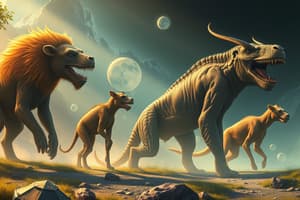Podcast
Questions and Answers
What is the definition of Evolution?
What is the definition of Evolution?
- New species
- Survival of the fittest
- Change over time (correct)
- Artificial selection
Change over time can result in _____.
Change over time can result in _____.
new species
Evolution occurs through the process of _____.
Evolution occurs through the process of _____.
natural selection
Natural selection is also known as _____.
Natural selection is also known as _____.
Evolution can also occur through _____.
Evolution can also occur through _____.
An example of artificial selection is _____.
An example of artificial selection is _____.
Evolution is supported by _____.
Evolution is supported by _____.
An example of anatomical evidence is _____.
An example of anatomical evidence is _____.
Vestigial structures like the _____.
Vestigial structures like the _____.
Evolution is supported by fossil evidence such as _____.
Evolution is supported by fossil evidence such as _____.
Evolution is also supported by molecular evidence such as _____.
Evolution is also supported by molecular evidence such as _____.
An example of anatomical evidence is _____.
An example of anatomical evidence is _____.
Homologous structures like the _____.
Homologous structures like the _____.
Evolution was established by _____.
Evolution was established by _____.
Darwin was a _____ .
Darwin was a _____ .
Darwin traveled to the _____.
Darwin traveled to the _____.
Darwin observed finches and _____.
Darwin observed finches and _____.
Darwin observed finches with different _____.
Darwin observed finches with different _____.
Darwin observed turtles with different _____.
Darwin observed turtles with different _____.
Flashcards are hidden until you start studying
Study Notes
Evolution Overview
- Evolution refers to the change in organisms over time, leading to the emergence of new species.
- The process of evolution is primarily driven by natural selection, which is also termed "survival of the fittest."
Natural and Artificial Selection
- Natural selection promotes the survival and reproduction of organisms best adapted to their environment.
- Artificial selection involves human intervention, leading to the development of various traits, such as different dog breeds.
Evidence Supporting Evolution
- Evolution is supported by various types of evidence, including anatomical, fossil, and molecular evidence.
Anatomical Evidence
- Anatomical evidence includes structures that provide insights into evolutionary relationships:
- Vestigial structures, such as the non-functional legs of a skink, are remnants from ancestors indicating evolutionary history.
- Homologous structures, like the forelimbs of bats and whales, show how different species share a common evolutionary origin.
Fossil Evidence
- Fossil records provide critical support for evolutionary theory, with significant finds such as whale bones demonstrating transitions between species over time.
Molecular Evidence
- DNA analysis offers molecular evidence supporting the connections between species and their evolutionary paths.
Historical Context of Evolution
- Charles Darwin, a notable naturalist, established foundational concepts of evolution through his work and observations.
- Darwin traveled to the Galapagos Islands, where he studied unique species such as finches and turtles, which informed his principles of natural selection.
Observational Findings
- Darwin observed variations in finch beaks, adapted to different food sources.
- He also noted the diversity in turtle shell shapes, reflecting adaptations to their specific environments.
Studying That Suits You
Use AI to generate personalized quizzes and flashcards to suit your learning preferences.




